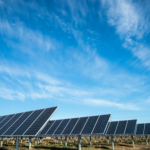As solar developers expand into new states or regions, a new solar design question often comes up: How should the design practices from the home office be mapped to the new locations or regions?
Historically, design choices were based specifically on a project’s latitude. Many solar engineers held that a module’s tilt had to be equal to the latitude at the location—and furthermore that the row spacing was calculated based on the shadows from the rows on the winter solstice (also impacted significantly by the location’s latitude).
Yet more recently, with less expensive hardware and improved software tools, the optimal design is evolving. So how much do an engineer’s optimal design choices differ from location to location? And how has that changed over time?
Historical design rules varied greatly by latitude
Historically, modules were tilted at or near the latitude of the project’s location. This would mean a 25° tilt in Miami, a 35° tilt in Raleigh, North Carolina and a 45° tilt in Seattle. This orientation optimizes for the sun angles throughout the year, pointing the modules as close as possible to the sun’s average position in the sky.
Then, the row spacing was typically defined based on a rule of not allowing inter-row shade on the winter solstice from 10 a.m. to 2 p.m. This created a double-whammy impact on row spacing. Not only are modules tilted more steeply at higher latitudes, but because the sun is lower in the horizon on the winter solstice in those northern locations, the shadows they cast are longer. As a result, the row spacing in northern latitudes was typically very large—in the example here, nearly 9’ in Seattle, compared to under 2’ in Miami.
These design rules are good for maintaining a high energy productivity per watt (specifically, optimizing kWh/kWp), but result in smaller systems when working on space-constrained rooftops. For example, the same rooftop that could support a 545-kWdc array in Miami would field just a 240-kWdc array in Seattle—a difference of over 55%! When modules were expensive, this was the right tradeoff to make. But as prices fell over time, the high-tilt approach made less and less sense.
Lower tilt with time-of-day spacing
With cheaper modules, a lower tilt becomes optimal: Squeeze more watts into a unit of area, sacrificing yield per peak-watt (kWh/kWp) to optimize total energy yield. Most systems were installed at relatively low tilts (typically 10 to 15°), yet the row spacing rule of avoiding shade on the winter solstice from 10 a.m. to 2 p.m. still persisted. This resulted in far greater harmonization between different systems.
While the sun angles on the winter solstice differ based on latitude, the net impact on row spacing is relatively modest (changing row spacing from ~1.2’ to ~1.6’), resulting in system sizes that are only about 10% different between Miami and Seattle.
Modern approach: Optimized row spacing
Finally, as modern software tools enabled system designers to quickly evaluate different combinations of row spacing and tilt, the final stage of design has been built around iteration and optimization.
In this world, how much variability is there from one location to the next? As Figure 5 shows, for most locations, the lowest possible tilt is best. It is only the two most northern locations (Spokane and Boston) where a higher tilt and wider spacing are optimal. This makes some sense, given the lower sun angles in northern latitudes.
As a result, a rooftop in Miami versus Seattle would vary in size by just 14%. More than if they were both installed at a 15° tilt, but not as significant as we thought heading in to this analysis.
The more things change, the more they stay the same
You would expect that as the industry shifts from “rules of thumb” to quantitative optimization, the optimal designs for different locations would diverge sharply based on the unique aspects of each site. After all, different locations have dramatically different weather patterns, temperatures and sun angles. But instead, the designs don’t change that much—and in fact, are far more harmonized than the original designs based on tilting at latitude.
Certainly, any system engineer who truly wants to squeeze out every dollar of their project should ensure that the tilt and spacing are optimized—after all, a 20-minute analysis could improve a project’s margin by 3 to 5%. But all in all, optimized systems across the country are trending toward looking more similar than different.
Footnotes:
Tilt: We are only looking at a minimum of 5° tilt. While lower tilts are theoretically possible, they increase soiling losses because rain does not wash off the dirt and dust from the modules.
Costs: This optimization analysis is based on the default cost structure from NREL’s System Advisor Model. We’re using identical cost assumptions for each location to keep it an apples-to-apples analysis, since we’re trying to isolate the impact of irradiance and sun angles—but we certainly understand that labor, permitting and interconnection costs can vary, sometimes significantly, from state to state.











Ok, now do an article about how all this influences back end/inverter design. Are modular inverters better in northern latitudes?
you haven’t factored in snow, first for the simple act of clearing the snow but also in locations where the mean temperature is below freezing for months at a time the depth of snow piling in the space between rows.
can helioscope generate the tilt vs row spacing matrix?
Great article!
I have a concern for tilt angle when working in locations between 15 & 23 degree latitude. This is due to sun will be relatively in the north during summer season. Moreover, during summer electricity consumption is the highest due to air conditioning. Therefore, considering above facts is it practical to use a title angle smaller than 5 degrees?
Great technical observations of the ole’ rule of thumb practices that we’ve been using for 20 + years.